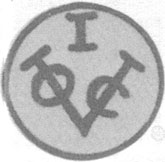| SPECIFICATIONS | |
| Denomination | Two Tanga |
| Alloy | Silver |
| Type | Struck |
| Diameter | 20.0 mm |
| Thickness | 1.8 mm |
| Weight legal | 4.00 gms |
| Weight | 3.78 gms |
| Shape | Round |
| Edge | Smooth |
| DieAxis | -45° |
| Mint | Goa,India |
| CounterMark | Jaffna |


|

|

| ||||||||||||||||||||||||||
| Codrington cf #121 ; Mitchiner 2149 ; KM cf#59 | ||||||||||||||||||||||||||||

| 
| 
|
The Countermark R is found either alone as in coin or in combination with the Countermark VOC-I only on silver double Tangas. This led to the conclusion that the R Countermark has been applied at Jaffna for a particular denomination.
Jan Lingen suggested in an article in a Dutch numismatic journal (De Beeldenaar Sept./Oct. 1996-200) that the R probably was applied on the coins to demonetize them and make them equal to the silver larin (Ridi). He suggests that the countermark has been applied at Jaffna during the period that, after its capture by the Dutch (City fell in 1658 March 9th, followed by the garrison on 1658 June 23rd), it was under the jurisdiction of the VOC-administration of the Coromandal Coast at Pulicat. When Jaffna came under the Colombo administration (1659 February) the countermarking with R ceased and according to the regulation prevailing, the double tangas in circulation were tested and countermarked with the mark of the Company (VOC-I). That is why you find the R countermark alone or in combination with the VOC-I.
By placard of 1660 October 23rd No silver or copper coins, were allowed in circulate after 1660 November 8th except those marked by the Company.
Codrington illustrates in PL-121 a coin of
this same type with only the R monogram.
Illustrated in Mitchiner
(2166) 16xx -- with Countermarks VOC-I of Jaffna on obverse and R on reverse.
(2168) 1652 -- Goa G A São João type double Tanga,
(2169) 1656 -- Diu Å D São João type double Tanga,
(2170) 16xx -- Goa G A São João type double Tanga with Countermark R on reverse.
Text from
* Ceylon Coins and Currency By H. W. Codrington. Colombo 1924
Chapter VIII Portuguese - Plate xxx. Page xxx
* The Coins of the Dutch Overseas Territories- 1601-1948
C. Scholten, 1953, Amsterdam: Jacques Schulman. page xxx-xxx
* Indo Portuguese Money, by J Ferraro Vaz, . Braga, Portugal 1980 p.163/4
* Moedas Portuguesas 1128-1988, by Alberto Gomes. Lisbon 1987
* Collection Henry Thomas Grogan, J. Schulman, Auction 23-02-1914.
* Non-Islamic and Western Colonies since 600 AD by by Michael Mitchiner.
The VF grade coin Scaned at 600 dpi are displayed at 300 dpi. It is from part of Lalith Raddella's collection I purchased in 2016 December.